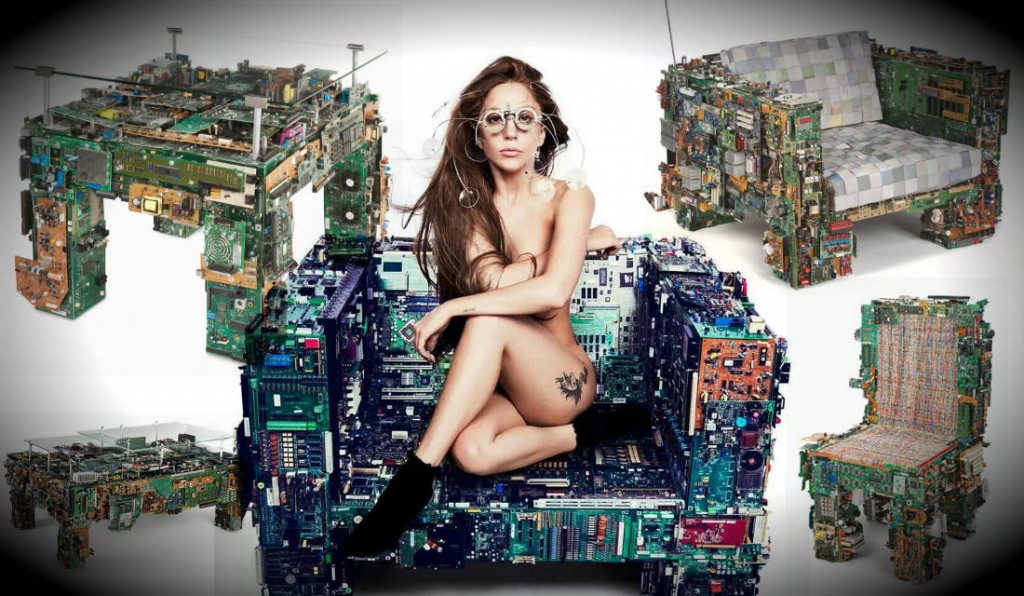Anúncios
Recycling has become an increasingly common practice in many industries, including furniture design. A striking example of this trend is the work of Benjamin Rollins Caldwell, a designer known for creating unique furniture from old computer parts. His designs not only showcase the versatility of recycled materials, but also bring a new perspective on what can be considered functional art.

A New Way of Recycling
When we think of recycling, we usually imagine plastic bottles or paper being transformed into new products. However, Benjamin Rollins Caldwell expanded on this idea by applying the concept of recycling to the creation of furniture. Using chips, motherboards, coolers, processors, hard drives and other electronic components, he developed chairs, tables and sofas that are true works of art.
These pieces of furniture are proof that almost anything can be repurposed. Instead of throwing away computer parts that are no longer useful, Caldwell found a way to give these materials a new lease of life by creating furniture that is not only functional, but also serves as unique decorative pieces.
The Art of Benjamin Rollins Caldwell: When Recycling Meets Design
Benjamin Rollins Caldwell, owner of BRC Designs, is a designer who has the ability to transform what would otherwise be electronic waste into furniture that stands out for its originality. His ability to combine recycling with furniture design has led him to collaborate with iconic figures such as Lady Gaga, which is no surprise considering the eccentric and innovative nature of his creations.
Caldwell’s furniture is made from 100% repurposed materials, reflecting his commitment to sustainability and innovation. What’s more, these pieces of furniture are not just design objects, but are also part of a larger movement that seeks to reduce environmental impact by recycling materials that would otherwise be discarded.
Challenges and Benefits
Creating furniture from computer parts is no easy task. One of the most obvious challenges is the maintenance of these pieces, such as dust removal, which can be a complex task, especially for furniture with many electronic parts. However, for technology and design enthusiasts, these pieces represent the pinnacle of creativity and sustainability.
In addition to the maintenance challenges, there is also the benefit of owning a piece of furniture that is completely unique. Each piece created by Caldwell is one of a kind, meaning that owners of these pieces of furniture have something that cannot be found anywhere else. This adds significant value, especially for those who appreciate art and innovation in interior design.
The Expansion of Recycling in Industry
Benjamin Rollins Caldwell’s work is not just an isolated example of recycling in furniture design, but part of a larger trend in the industry. Increasingly, designers are exploring ways to repurpose discarded materials to create innovative, sustainable furniture. This includes everything from reusing reclaimed wood to repurposing metals and plastics.
This approach not only helps reduce waste, but also raises awareness about the importance of recycling. By choosing furniture made from recycled materials, consumers are supporting sustainable practices and encouraging the industry to adopt more environmentally friendly production methods.
Innovation in Recycling: A House Made from Pieces of a Boeing 747
If furniture made from computer parts seems innovative, a house built from parts of a Boeing 747 is even more impressive. This project, which exemplifies the boundless creativity of sustainable design, shows how recycling can be applied on a much larger scale, transforming waste into habitable structures.
Much like Caldwell’s furniture, this home is a testament to the potential of upcycling in architecture and design. Using parts of an airplane to build a home not only reduces the environmental impact, but also creates a unique and functional space that defies traditional building norms.
Recycling and the Future
As awareness of the importance of recycling grows, so does the demand for sustainable furniture. Designers like Benjamin Rollins Caldwell are at the forefront of this shift, demonstrating that it is possible to create high-quality, stylish pieces from recycled materials.
The future of furniture, therefore, seems to be intrinsically linked to recycling and sustainability. With more consumers seeking options that reflect their environmental values, the furniture industry is adapting to offer products that not only meet these demands, but also raise the bar for sustainable design.
Caldwell’s work is an inspiring example of how recycling can be applied in innovative ways to furniture design. His use of computer parts to create unique furniture is a clear demonstration that sustainability and creativity can go hand in hand, resulting in pieces that are both functional and artistic.
If you’ve been inspired by Benjamin Rollins Caldwell’s work and want to explore more about sustainable furniture and recycling in design, keep reading our articles. Recycling isn’t just an environmental necessity; it’s an opportunity to transform the ordinary into the extraordinary.
Learn how to make other arts by recycling, Click here.
Check out interesting facts about recycling clicking here.


